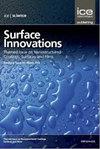High-temperature oxidation behavior of CeO2 doped MAO coatings on TC4 titanium alloy
IF 3.5
4区 材料科学
Q3 CHEMISTRY, PHYSICAL
引用次数: 1
Abstract
To improve the surface micropores and high-temperature oxidation resistance of micro-arc oxidation (MAO) coating on TC4 titanium alloy, cerium dioxide (CeO2) particles were introduced into the electrolyte to prepare MAO composite coatings with different CeO2 content. X-ray diffractometer, scanning electron microscope and multifunctional material surface performance tester were used to analyze the phase composition, surface morphology and bonding force of the samples. TC4 substrate, undoped MAO sample and optimally doped MAO sample were oxidized at 650°C, 750°C and 850°C respectively. The results show that the best doped MAO samples show excellent high-temperature oxidation resistance at three temperatures. Compared with the undoped MAO sample, the maximum oxidation weight gain per unit area of the optimally doped MAO sample decreased by 10.8%, 19.6% and 22.1%, respectively. This is mainly because the thickness, hardness and adhesion of MAO coating are all increased by doping CeO2 particles, and a dense protective layer can also be formed on the surface of TC4 substrate. The invasion of oxygen medium is effectively prevented. In this research work, the optimal addition amount of CeO2 is 6 g/L.TC4钛合金表面CeO2掺杂MAO涂层的高温氧化行为
为了改善TC4钛合金微弧氧化(MAO)涂层的表面微孔和耐高温氧化性能,将二氧化铈(CeO2)颗粒引入电解质中,制备了不同CeO2含量的MAO复合涂层。利用X射线衍射仪、扫描电子显微镜和多功能材料表面性能测试仪对样品的相组成、表面形貌和结合力进行了分析。分别在650°C、750°C和850°C下氧化TC4衬底、未掺杂的MAO样品和最佳掺杂的MAO样品。结果表明,最佳掺杂的MAO样品在三种温度下都表现出优异的高温抗氧化性能。与未掺杂的MAO样品相比,最佳掺杂的MAO样品的单位面积最大氧化增重分别降低了10.8%、19.6%和22.1%。这主要是因为掺杂CeO2颗粒提高了MAO涂层的厚度、硬度和附着力,并且在TC4衬底表面也可以形成致密的保护层。有效地防止了氧气介质的侵入。在本研究工作中,CeO2的最佳添加量为6 g/L。
本文章由计算机程序翻译,如有差异,请以英文原文为准。
求助全文
约1分钟内获得全文
求助全文
来源期刊

Surface Innovations
CHEMISTRY, PHYSICALMATERIALS SCIENCE, COAT-MATERIALS SCIENCE, COATINGS & FILMS
CiteScore
5.80
自引率
22.90%
发文量
66
期刊介绍:
The material innovations on surfaces, combined with understanding and manipulation of physics and chemistry of functional surfaces and coatings, have exploded in the past decade at an incredibly rapid pace.
Superhydrophobicity, superhydrophlicity, self-cleaning, self-healing, anti-fouling, anti-bacterial, etc., have become important fundamental topics of surface science research community driven by curiosity of physics, chemistry, and biology of interaction phenomenon at surfaces and their enormous potential in practical applications. Materials having controlled-functionality surfaces and coatings are important to the manufacturing of new products for environmental control, liquid manipulation, nanotechnological advances, biomedical engineering, pharmacy, biotechnology, and many others, and are part of the most promising technological innovations of the twenty-first century.
 求助内容:
求助内容: 应助结果提醒方式:
应助结果提醒方式:


